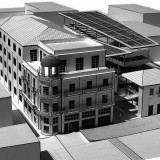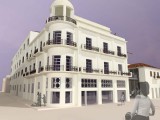The building complex of the former Matsaggos Tobacco Industry is located in the centre of the city of Volos, surrounded by 28th Octovriou, P.Mela, Ermou and Macedonomachon streets. It consists of five buildings altogether, built from 1920 to 1936, therefore each one belonging in a different era. As a result, every building is of a distinctive architectural style. The University of Thessaly is in possession of this building complex which has been designated as preservable.
The purpose of this Senior Thesis is to negotiate the fulfillment of the architectural intervention, intending to reutilize the rest of the unexploited Matsaggos complex, which is about 2000 m² in area, situated on the streets of P.Mela, Ermou and Macedonomachon.
This architectural study suggests a triple gradation as follows: a building internally and externally preservable, an eclectistic building-masterpiece of art in which no intervention will be permitted, and a building to which two policies will be implemented. On the one hand, part of the building is to be maintained, as its already existing canvas serves us to a great extent and, on the other hand, the rest of the building is going to be demolished. In order for the desired effect to be achieved, we have to follow three stages. To begin with, there will be no intervention in the preservable Building C. The same strategy remains valid for part of the Building B on P.Mela Street, applying the required partitions and supporting it internally with a layer of concrete. The façade of Matsaggos Gallery (Stoa Matsaggou) on Macedonomachon Street will also remain intact as conducted by previous planners and architects regarding the upper building of the Faculty of Financial Studies, so that the harmony of all façades in a row can be preserved. However, we are going to intervene drastically in the interior of the façades with the construction of a metallic building, intending not to obscure but to give prominence to the existing monument.
The building will be utilized by the Students’ Community in terms of supplementary auditoriums for the coastal University Campus, also providing additional facilities for the university students (an internet café, a restaurant, offices for students’ associations, etc.). Furthermore, thanks to its outstanding position in the heart of the city of Volos, it can serve as a venue for exhibitions and presentations of educational projects, offering local people the opportunity to benefit from such events at the same time.
In conclusion, the purpose of this study is to overcome the decay and obsolescence that has been inflicted on this building complex so far and bring about a new model of interconnection between a University Building and the city of Volos.







